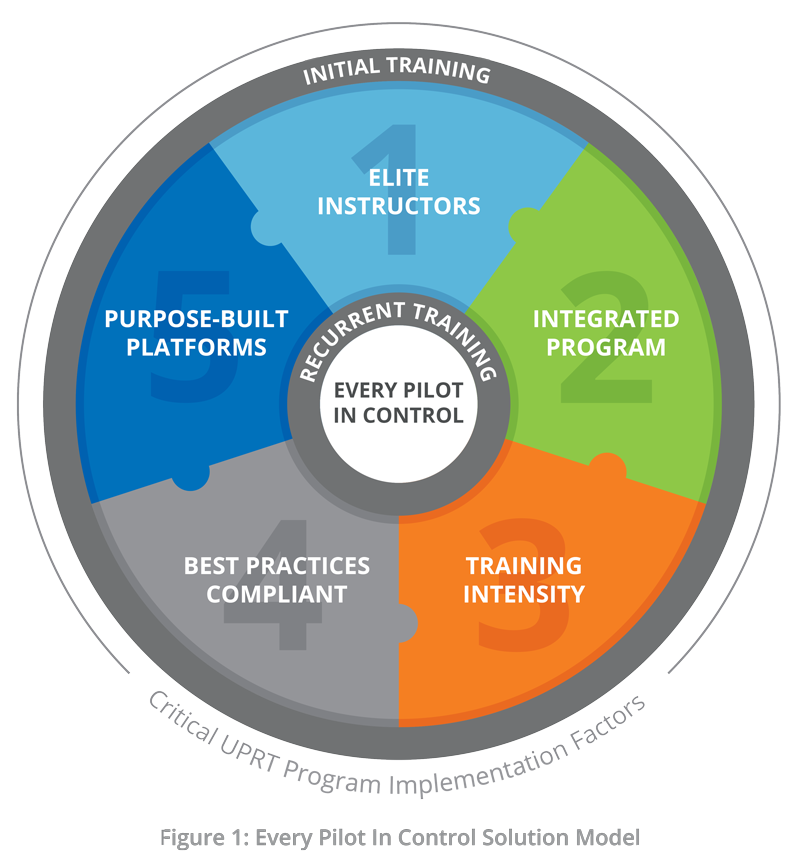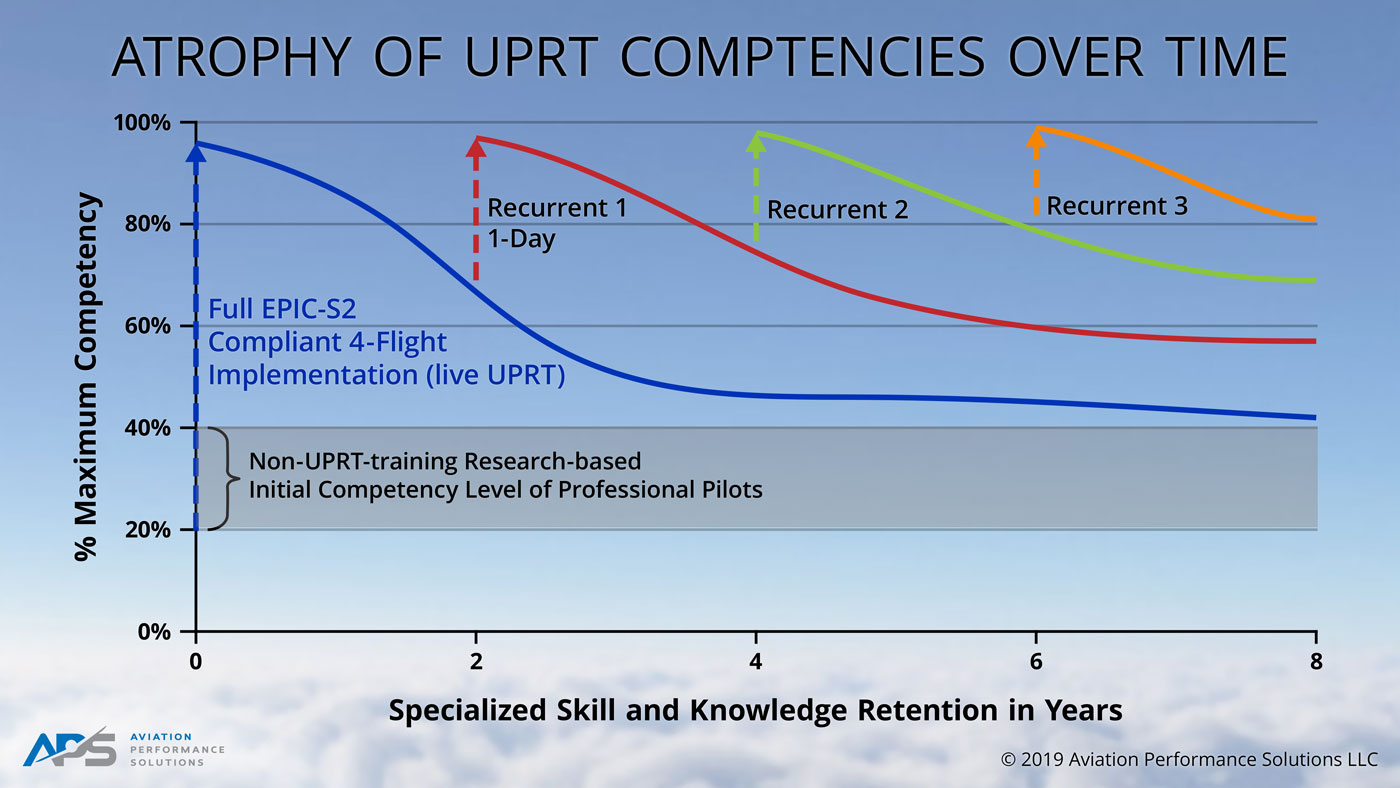By Paul BJ Ransbury, CEO at Aviation Performance Solutions (APS)
 The Every Pilot In Control Solution Standard™ (EPIC-S2™) encompasses the key factors that have proven to be critical in successful Upset Prevention and Recovery Training (UPRT) implementation that results in substantially reducing the risk of Loss of Control In-flight (LOC-I). To learn more about EPIC-S2 and the high-level role of all six factors in effective UPRT, please visit the EPIC-S2 Upset Prevention and Recovery Training page. In this article, we address the two dimensions of EPIC-S2 Training Intensity and its critical role in effective UPRT.
The Every Pilot In Control Solution Standard™ (EPIC-S2™) encompasses the key factors that have proven to be critical in successful Upset Prevention and Recovery Training (UPRT) implementation that results in substantially reducing the risk of Loss of Control In-flight (LOC-I). To learn more about EPIC-S2 and the high-level role of all six factors in effective UPRT, please visit the EPIC-S2 Upset Prevention and Recovery Training page. In this article, we address the two dimensions of EPIC-S2 Training Intensity and its critical role in effective UPRT.
Who is APS and Why Listen
Aviation Performance Solutions is the world’s largest and most diversified provider of UPRT solutions with three decades of full-time dedication to developing Loss of Control In-flight (LOC-I) solutions. Headquartered in Mesa, Arizona USA, we have multiple locations in the United States and Europe. APS provides more professional pilots with comprehensive Upset Prevention and Recovery Training (UPRT) designed to solve LOC-I than any other training provider. UPRT is not a side business for us – it is our primary focus every day.
We care about every pilot’s safety and the safety of their passengers, our family, friends, and fellow humans that tragically die needlessly by the hundreds every year around the world due to LOC-I. At APS, we have a powerful career-long plan for every graduate that is comprehensive, economical, industry-leading and highly effective. EPIC-S2 represents our best efforts at giving back to the industry to help advance its effectiveness at overcoming the deadly LOC-I threat. At APS, our purpose is powerfully and simply …
We Help Pilots Bring Everyone Home Safely
Learn more at apstraining.com/about.
Review – Six Critical UPRT Program Implementation Factors
 The Every Pilot In Control Solution Standard™ (EPIC-S2™) encompasses the key factors that have proven to be critical in successful Upset Prevention and Recovery Training (UPRT) implementation that results in substantially reducing the risk of Loss of Control In-flight (LOC-I) for graduating pilots. The Every Pilot In Control Solution Model (Figure. 1) conceptually represents how these critical factors work together to maximize the efforts of training providers so that UPRT accomplishes what it is intended to do — save lives.
The Every Pilot In Control Solution Standard™ (EPIC-S2™) encompasses the key factors that have proven to be critical in successful Upset Prevention and Recovery Training (UPRT) implementation that results in substantially reducing the risk of Loss of Control In-flight (LOC-I) for graduating pilots. The Every Pilot In Control Solution Model (Figure. 1) conceptually represents how these critical factors work together to maximize the efforts of training providers so that UPRT accomplishes what it is intended to do — save lives.
Loss of Control In-flight (LOC-I) has persisted for over a decade as the number one cause of fatalities across all sectors of aviation. Because current civil pilot certification training does not comprehensively address the unique and counterintuitive skills necessary to recognize, prevent and overcome LOC-I, Upset Prevention and Recovery Training (UPRT) is needed to fill this training gap.
Improperly conducted UPRT results in ineffective training and often unintentionally generates increased risk to pilots and their passengers throughout their career due to negative training and/or negative transfer of skill. It is imperative that specific guidelines be tested and adopted in order to ensure safety during training and that the skills learned are truly effective in mitigating the risk of LOC-I. In this discussion, we get into more detail concerning UPRT Implementation, specifically Training Intensity.
Two Dimensions of Intensity Considered Critical to Effective UPRT
In an unexpected airplane upset, accurate decision-making, resilience and measured reaction times are critical. There are two dimensions to training intensity critical to a successful UPRT program:
EPIC-S2 Training Intensity – Dimension #1: Frequency Over Time
The first dimension of training intensity is simply the training flight frequency over the duration of the training course. Behavioral studies show that practicing a skill multiple times intensely in a focused, deliberate manner over multiple days develops deeper learning, faster decision-making and precise reaction time with accurate control response under stress1.
A UPRT program must provide sufficient high-frequency practice opportunities so that the skills learned remain ingrained and, if installed correctly, second nature should an unexpected airplane upset happen six months or possibly as much as a couple of years after the training occurs; it depends on the intensity of the initial training, efforts made by the pilot to stay current on UPRT strategy (available via APS online resources), and history of recurrent training. On the topic of recurrent training, it is shorter and tops up skills quickly to peak performance, typically in a single day. This seemingly ‘abbreviated’ recurrent training, ideally on an annual basis, boosts the longevity of the skill set and keeps the pilot grounded in both the underlying knowledge and the application of the motor skills in a diversity of training, scenario, and stress conditions. This success is only possible when the initial training is done with intensity and in compliance with the other critical UPRT program implementation factors specified by EPIC-S2. In fact, recurrent training specifically is addressed in more detail in the EPIC-S2 Critical Factor #6: Initial and Recurrent Training that’s beyond the scope of this particular article.
EPIC-S2 Training Intensity – Dimension #2: Overcoming Incapacitating Human Factors
The second dimension of training intensity involves the depth and frequency of human factors integrated into core skill development within each flight. It concerns overcoming complicating and potentially incapacitating human factors in a crisis event2. In an unexpected airplane upset, the human factors responses of startle and surprise can undo a pilot’s ability to think clearly and respond accurately. The human psychophysiology just works differently in the real world compared to simulator. Intense live on-aircraft training, which puts pilots in upset situations and requires them to repeatedly overcome the associated fear, confusion and uncertainty, allows pilots to become familiar with the maneuvers and overcome the human factors related to operating beyond the extended envelope.
EPIC-S2 Compliance Standards on Training Intensity
The EPIC-S2 UPRT Provider Compliance Guide outlines specific requirements related to intensity that are required for maximum skill development and retention over time. As alluded to above, the mental modeling and resilience learning process in UPRT, especially on-aircraft UPRT, follows a well-established cognitive learning process. In short, the specifics of EPIC-S2 on Training Intensity address the following areas:
- Overall number of training sessions
- Duration and content of training sessions
- Role, duration, and placement of academic / ground training
- Unique roles, proportional use, and optimization of integrated academic, on-aircraft, and simulation resources when used together or separately.
It should not be surprising that the learning journey in effective and real-world-transferrable UPRT is not a straight line of ever-increase awareness, skill, and knowledge. Decades of experience in UPRT implementation of many thousands of pilots shows the following path in well over 90% of professional pilots undergoing training:
- One training session is marginally better than no training at all,
- Two training sessions are typically worse than no training due to sensitization3,
- Three training sessions are more than 3X effective than one session, yet only 60% of the peak performance of four training sessions,
- Four training sessions results in effective, safe performance in excess of 90%, and
- The long-term level of retained competence is lower in proportion to the level of the initial skill set’s establishment. See graphic below.

In Summary
Every dimension of the EPIC-S2 implementation is critical in its own way. The real power of EPIC-S2 is only realized when all Six Critical UPRT Program Implementation Factors are optimized together. A weakness in any one area has substantial impact on the overall effectiveness of the training.
Footnotes
1Bosse, H. M., Mohr, J., Buss, B., Krautter, M., Weyrich, P., Herzog, W., … Nikendei, C. (2015, February 19). The benefit of repetitive skills training and frequency of expert feedback in the early acquisition of procedural skills. Retrieved October 15, 2019, from https://www.ncbi.nlm.nih.gov/pmc/articles/PMC4339240/
2Szalma, J. L., & Hancock, P. A. A. (2017). Performance Under Stress. London: Taylor and Francis. doi: https://www.taylorfrancis.com/books/e/9781315599946/chapters/10.1201/9781315599946-6
3Sensitization, also referred to as reverse tolerance, is a phenomenon in which following repeated exposure to the same dose of a particular drug of abuse, a specific behavioral, physiological, or cellular response increases, rather than decreases, over time. https://www.sciencedirect.com/topics/psychology/sensitization




Comments: